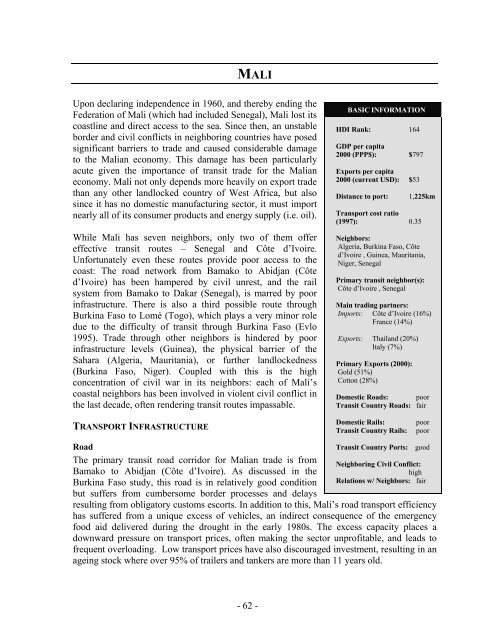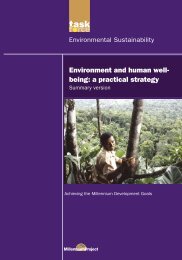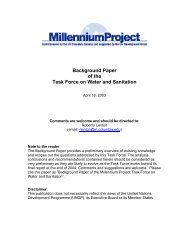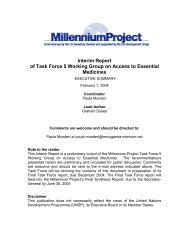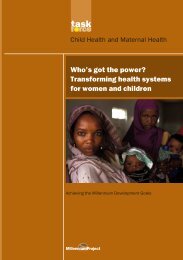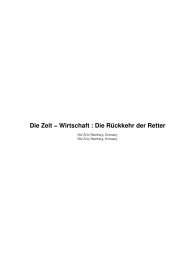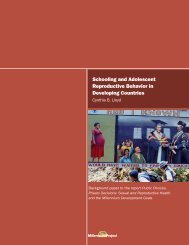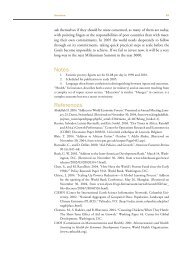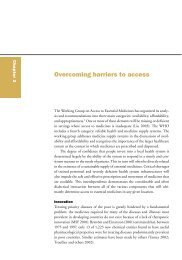the challenges facing landlocked developing countries: a case study ...
the challenges facing landlocked developing countries: a case study ...
the challenges facing landlocked developing countries: a case study ...
You also want an ePaper? Increase the reach of your titles
YUMPU automatically turns print PDFs into web optimized ePapers that Google loves.
MALI<br />
Upon declaring independence in 1960, and <strong>the</strong>reby ending <strong>the</strong><br />
Federation of Mali (which had included Senegal), Mali lost its<br />
coastline and direct access to <strong>the</strong> sea. Since <strong>the</strong>n, an unstable<br />
border and civil conflicts in neighboring <strong>countries</strong> have posed<br />
significant barriers to trade and caused considerable damage<br />
to <strong>the</strong> Malian economy. This damage has been particularly<br />
acute given <strong>the</strong> importance of transit trade for <strong>the</strong> Malian<br />
economy. Mali not only depends more heavily on export trade<br />
than any o<strong>the</strong>r <strong>landlocked</strong> country of West Africa, but also<br />
since it has no domestic manufacturing sector, it must import<br />
nearly all of its consumer products and energy supply (i.e. oil).<br />
While Mali has seven neighbors, only two of <strong>the</strong>m offer<br />
effective transit routes – Senegal and Côte d’Ivoire.<br />
Unfortunately even <strong>the</strong>se routes provide poor access to <strong>the</strong><br />
coast: The road network from Bamako to Abidjan (Côte<br />
d’Ivoire) has been hampered by civil unrest, and <strong>the</strong> rail<br />
system from Bamako to Dakar (Senegal), is marred by poor<br />
infrastructure. There is also a third possible route through<br />
Burkina Faso to Lomé (Togo), which plays a very minor role<br />
due to <strong>the</strong> difficulty of transit through Burkina Faso (Evlo<br />
1995). Trade through o<strong>the</strong>r neighbors is hindered by poor<br />
infrastructure levels (Guinea), <strong>the</strong> physical barrier of <strong>the</strong><br />
Sahara (Algeria, Mauritania), or fur<strong>the</strong>r <strong>landlocked</strong>ness<br />
(Burkina Faso, Niger). Coupled with this is <strong>the</strong> high<br />
concentration of civil war in its neighbors: each of Mali’s<br />
coastal neighbors has been involved in violent civil conflict in<br />
<strong>the</strong> last decade, often rendering transit routes impassable.<br />
BASIC INFORMATION<br />
HDI Rank: 164<br />
GDP per capita<br />
2000 (PPP$): $797<br />
Exports per capita<br />
2000 (current USD): $53<br />
Distance to port:<br />
1,225km<br />
Transport cost ratio<br />
(1997): 0.35<br />
Neighbors:<br />
Algeria, Burkina Faso, Côte<br />
d’Ivoire , Guinea, Mauritania,<br />
Niger, Senegal<br />
Primary transit neighbor(s):<br />
Côte d’Ivoire , Senegal<br />
Main trading partners:<br />
Imports: Côte d’Ivoire (16%)<br />
France (14%)<br />
Exports: Thailand (20%)<br />
Italy (7%)<br />
Primary Exports (2000):<br />
Gold (51%)<br />
Cotton (28%)<br />
Domestic Roads: poor<br />
Transit Country Roads: fair<br />
TRANSPORT INFRASTRUCTURE<br />
Domestic Rails:<br />
Transit Country Rails:<br />
poor<br />
poor<br />
Road<br />
The primary transit road corridor for Malian trade is from<br />
Bamako to Abidjan (Côte d’Ivoire). As discussed in <strong>the</strong><br />
Burkina Faso <strong>study</strong>, this road is in relatively good condition<br />
but suffers from cumbersome border processes and delays<br />
Transit Country Ports: good<br />
Neighboring Civil Conflict:<br />
high<br />
Relations w/ Neighbors: fair<br />
resulting from obligatory customs escorts. In addition to this, Mali’s road transport efficiency<br />
has suffered from a unique excess of vehicles, an indirect consequence of <strong>the</strong> emergency<br />
food aid delivered during <strong>the</strong> drought in <strong>the</strong> early 1980s. The excess capacity places a<br />
downward pressure on transport prices, often making <strong>the</strong> sector unprofitable, and leads to<br />
frequent overloading. Low transport prices have also discouraged investment, resulting in an<br />
ageing stock where over 95% of trailers and tankers are more than 11 years old.<br />
- 62 -


